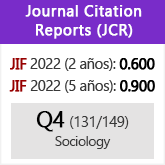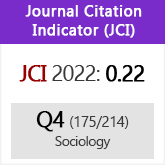¿Y después de la universidad qué? Análisis de las transiciones del sistema educativo al empleo en España
DOI:
https://doi.org/10.3989/ris.2020.78.3.18.133Palabras clave:
Campos de estudio, Desigualdades de género, Estudios universitarios, Mercado laboral, Segregación sexual horizontalResumen
Este artículo analiza la inserción laboral de los titulados universitarios en España. Mediante una muestra de 23 885 graduados en 2009 se estudian las probabilidades de acceso al empleo cinco años después de la obtención de la titulación. Los resultados muestran que, si bien las probabilidades de acabar sobreeducados son altas para hombres y mujeres, una mayor inversión educativa asegura mejores oportunidades laborales para ambos. Además, se confirma que las mujeres, en igualdades formativas, tienen más dificultades que los hombres para acceder a los empleos de calidad. Asimismo, se establece que mientras que las carreras que presentan mayor empleabilidad son las sanitarias y las ingenierías, las que peores posibilidades laborales presentan son las científicas, las ciencias sociales y las humanísticas. Por último, se comprueba que los hombres con estudios masculinizados tienen más facilidades para insertarse laboralmente y menores probabilidades de acabar sobreeducados que las mujeres con las mismas características.
Descargas
Citas
Anker, R. 1997. "Theories of occupational segregation by sex : An overview". International Labour Review 136(3): 315-339.
Ballarino, G. y M. Bratti. 2009. "Field of Study and University Graduates' Early Employment Outcomes in Italy during 1995-2004". Labour 23(3): 421-457. https://doi.org/10.1111/j.1467-9914.2009.00459.x
Barone, C. 2011. "Some Things Never Change : Gender Segregation in Higher Education across Eight Nations and Three Decades". Sociology of Education 84(2): 157- 176. https://doi.org/10.1177/0038040711402099
Becker, G. S. 1985. "Human Capital, Effort, and the Sexual Division of Labor". Journal of Labor Economics 3(1): s33-s58. https://doi.org/10.1086/298075
Becker, G. S. 1993. Human capital: A theoretical and empirical analysis, with special reference to education (3ª ed.). Chicago: The University of Chicago Press. https://doi.org/10.7208/chicago/9780226041223.001.0001
Benson, A. 2015. "A Theory of Dual Job Search and Sex- Based Occupational Clustering". Industrial Relations 54(3): 367-400. https://doi.org/10.1111/irel.12095
Berman, E., Bound, J. y S. Machin. 1998. "Implications of Skill- Biased Technological Change : International Evidence". The Quartely Journal of Economics 113(4): 1245-1279. https://doi.org/10.1162/003355398555892
Breen, R. 2005. "Explaining cross-national variation in youth unemployment: Market and institutional factors". European Sociological Review 21(2):125-134. https://doi.org/10.1093/esr/jci008
Caballero Fernández, G., López-Miguens M. J. y J. F. Lampón. 2014. "La universidad y su implicación con la empleabilidad de sus graduados". Revista Española de Investigaciones Sociológicas 146(2):23-46.
Capsada-Munsech, Q. 2015. "The role of social origin and field of study on graduates' overeducation: the case of Italy". Higher Education 69(5):779-807. https://doi.org/10.1007/s10734-014-9805-2
Capsada-Munsech, Q. 2016. "Overeducation : Incidence, Persistence and Institutional Differences across countries". Tesis doctoral. Departamento de Ciencias Políticas y Sociales de la Universitat Pompeu Fabra. Barcelona.
Cazorla González-Serrrano, M. C. 2011. "Una aproximación a los aspectos positivos y negativos derivados de la puesta en marcha del Plan Bolonia en la Universidad Española". REJIE: Revista Jurídica de Investigacion e Innovación Educativa 4(1): 91-104.
Cejka, M. A. y A. H. Eagly. 1999. "Gender-stereotypic images of occupations correspond to the sex segregation of employment". Personality and Social Psychology Bulletin 25(4):413-423. https://doi.org/10.1177/0146167299025004002
Charles, M. y K. Bradley. 2009. "Indulging our gendered selves? Sex segregation by field of study in 44 countries". American Journal of Sociology 114(4):924-976. https://doi.org/10.1086/595942 PMid:19824299
Dill, J. S., Price-Glynn K. y C. Rakovski. 2016. "Does the "Glass Escalator" Compensate for the Devaluation of Care Work Occupations?: The Careers of Men in Low- and Middle-Skill Health Care Jobs". Gender and Society 30(2):334-360. https://doi.org/10.1177/0891243215624656
Dwyer, R. E. 2013. "The Care Economy? Gender, Economic Restructuring, and Job Polarization in the U.S. Labor Market". American Sociological Review 78(3):390-416. https://doi.org/10.1177/0003122413487197
England, P. 2010. "The gender revolution: Uneven and stalled". Gender and Society 24(2):149-166. https://doi.org/10.1177/0891243210361475
Fachelli, S. y J. Planas. 2011. "Equidad y movilidad intergeneracional de los titulados universitarios catalanes". Papers. Revista de Sociología 96(4):1283-1307. https://doi.org/10.5565/rev/papers/v96n4.353
Fachelli, S., Torrents, D. y J. Navarro-Cendejas. 2014. "¿La universidad española suaviza las diferencias de clase en la inserción laboral?" Revista de Educación 364:119-144.
Fernández Dueñas, D., Iglesias Fernández, C. y R. Llorente Heras. 2016. "¿Por qué las mujeres no se distribuyen de forma homogénea en el mercado de trabajo español? El "efecto rechazo" y el "efecto atracción". El Trimestre Económico 83(330): 339-369. https://doi.org/10.20430/ete.v83i330.202
Giesecke, J. y S. Schindler. 2008. "Field of study and flexible work: A comparison between Germany and the UK". International Journal of Comparative Sociology 49(4-5):283-304. https://doi.org/10.1177/0020715208093078
Glass, J. L., Sassler, S., Levitte, Y. y K. M. Michelmore. 2013. "What's So Special about STEM ? A Comparison of Women's Retention in STEM and Professional Occupations". Social Forces 92(2):723-756. https://doi.org/10.1093/sf/sot092 PMid:25554713 PMCid:PMC4279242
Glick, P., K. Wilk y M. Perreault. 1995. "Images of occupations: Components of gender and status in occupational stereotypes". Sex Roles 32(9-10):565-582. https://doi.org/10.1007/BF01544212
González-Ramos, A. M., Vergés Bosch, N. y J. S. Martínez- García. 2017. "Las mujeres en el mercado de trabajo de las tecnologías". Revista Española de Investigaciones Sociologicas, 159:73-90. https://doi.org/10.5477/cis/reis.159.73
Grönlund, A. y C. Magnusson. 2017. "Do atypical individuals make atypical choices? Examining how gender patterns in personality relate to occupational choice and wages among five professions in Sweden". Gender Issues, 35(2):153-178. https://doi.org/10.1007/s12147-017-9194-9
Hultin, M. 2003. "Some Take the Glass Escalator, Some Hit the Glass Ceiling? Career Consequences of Occupational Sex Segregation". Work and Occupations, 30(1): 30-61. https://doi.org/10.1177/0730888402239326
Instituto Nacional de Estadística. 2016. "Encuesta de Inserción Laboral de Titulados Universitarios". Madrid. https://www.ine.es/uc/b8pcJROS [Consulta 1 de Septiembre de 2018]
Instituto Nacional de Estadística. 2017. "Microdatos de la Encuesta de Población Activa". Madrid. https://www.ine. es/uc/e7b0xaBC [Consulta 1 de Septiembre de 2018]
Istituto nazionale di statistica, INS. 2007. "Indagine Statistica sull'Inserimento Professionale dei Laureati". Rome. Istituto nazionale di statistica.
Istituto nazionale di statistica, INS. 2010. "Il laureati e il mercato del lavoro". Rome. Istituto nazionale di statistica.
Jerrim, J., Parker, P. D., Chmielewski, A. K. y J. Anders. 2016. "Private Schooling, Educational Transitions, and Early Labour Market Outcomes: Evidence from Three Anglophone Countries". European Sociological Review 32(2):280-294. https://doi.org/10.1093/esr/jcv098
Kahalon, R., Shnabel, N. y J. C. Becker. 2018. "Positive stereotypes, negative outcomes: Reminders of the positive components of complementary gender stereotypes impair performance in counter-stereotypical tasks". British Journal of Social Psychology 57(2):482-502. https://doi.org/10.1111/bjso.12240 PMid:29377186
Katz-Gerro, T. y M. Yaish. 2003. "Higher Education: is more better? Gender Differences in Labour Market Returns to Tertiary Education in Israel". Oxford Review of Education 29(4):571-592. https://doi.org/10.1080/0305498032000153089
Lassibille, G., Navarro Gómez, L., Aguilar Ramos, I. y C. De La O Sánchez. 2001. "Youth transition from school to work in Spain". Economics of Education Review 20(2):139-149. https://doi.org/10.1016/S0272-7757(99)00068-0
Leuze, K. y S. Strauß. 2016. "Why do occupations dominated by women pay less? How 'female-typical' work tasks and working-time arrangements affect the gender wage gap among higher education graduates". Work, Employment and Society 30(5): 802-820. https://doi.org/10.1177/0950017015624402
Levanon, A., England. P. y P. Allison. 2009. "Occupational Feminization and Pay : Assessing Causal Dynamics Using 1950-2000 U.S. Census Data". Social Forces 88(2):865-891. https://doi.org/10.1353/sof.0.0264
Luhaorg, H. y M. T. Zizian. 1995. "Gender Role Conflict: The Interaction of Gender, Gender Role, and Occupation". Sex Roles 33:607-620. https://doi.org/10.1007/BF01547720
Macmillan, L., Tyler, C. y A. Vignoles. 2015. "Who Gets the Top Jobs? The Role of Family Background and Networks in Recent Graduates' Access to High-status Professions". Journal of Social Policy 44(3):487-515. https://doi.org/10.1017/S0047279414000634
Manning, A. 2004. "We Can Work It Out: the Impact of Technological Change on the Demand for Low Skill Workers". Scottish Journal of Political Economy 51(5):581-609. https://doi.org/10.1111/j.0036-9292.2004.00322.x
Martínez-García, J. S. 2017. "Sobrecualificación de los titulados universitarios y movilidad social". Papers. Revista de Sociología 102(1):29-52. https://doi.org/10.5565/rev/papers.2225
Maume, D. J. 1999. "Glass Ceilings and Glass Escalators: Occupational Segregation and Race and Sex Differences in Managerial Promotions". Work and Occupations 26(4):483-509. https://doi.org/10.1177/0730888499026004005
Ministerio de Educación, Cultura y Deporte. 2017. Panorama de la educación: Indicadores de la OCDE 2017. Madrid: Subdirección General de Documentación y Publicaciones. ISBN: 978-84-369-5806-5
Ochsenfeld, F. 2014. "Why do women's fields of study pay less? A test of devaluation, human capital, and gender role theory". European Sociological Review 30(4):536- 548. https://doi.org/10.1093/esr/jcu060
Organización para la Cooperación y el Desarrollo Económico. (2017). Report on the implementation of the OECD gender recommendations: some progress on gender equality but much left to do. Meeting of the OECD council at ministerial level. Paris. OECD Publications.
Ortiz, L. y A. Kucel. 2008. "Do Fields of Study Matter for Over-education?: The Cases of Spain and Germany". International Journal of Comparative Sociology 49(4-5):305-327. https://doi.org/10.1177/0020715208093079
Ortiz, L. y J. Rodríguez-Menés. 2016. "The positional value of education and its effect on general and technical fields of education: Educational expansion and occupational returns to education in Spain". European Sociological Review 32(2):216-237. https://doi.org/10.1093/esr/jcv085
Ortiz, L. y M. H. J. Wolbers. 2011. "The role of educational expansion in the early occupational attainment process : Empirical evidence from a cross-national perspective". UPF Working Paper nº 9. Departamento de Ciencias Políticas y Sociales, UPF. Barcelona. https://bit. ly/3hwHex0 [Consulta el 20 de Agosto de 2018]
Polachek, S. 1981. "Occupational Self-Selection: A Human Capital Approach to Sex Differences in Occupational Structure". The Review of Economics and Statistics 63(1):60-69. https://doi.org/10.2307/1924218
Price-Glynn, K. y C. Rakovski. 2012. "Who rides the glass escalator? Gender, race and nationality in the national nursing assistant study". Work, Employment and Society 26(5):699-715. https://doi.org/10.1177/0950017012451634
Reimer, D. y S. Steinmetz. 2009. "Highly Educated But in the Wrong Field?" European Societies 11(5):723-746. https://doi.org/10.1080/14616690802326400
Reisel, L. 2013. "Is more always better? Early career returns to education in the United States and Norway". Research in Social Stratification and Mobility 31(1): 49-68. https://doi.org/10.1016/j.rssm.2012.10.002
Schröder, H. y H. B. G. Ganzeboom. 2014. "Measuring and modelling level of education in European societies". European Sociological Review 30(1):119-136. https://doi.org/10.1093/esr/jct026
Snyder, K. A. y A. I. Green. 2008. "Revisiting the Glass Escalator: The Case of Gender Segregation in a Female Dominated Occupation". Social Problems 55(2):271- 299. https://doi.org/10.1525/sp.2008.55.2.271
Srivastava, S. B. y E. L. Sherman. 2015. "Agents of Change or Cogs in the Machine ? Reexamining the Influence of Female Managers on the Gender Wage Gap". American Journal of Sociology 120(6):1778-1808. https:// www.jstor.org/stable/10.1086/681960 https://doi.org/10.1086/681960
Statistiska Centralbyrån (2009). "Students having completed upper secondary school education by programme, enrolment in higher education within three years and sex. Academic year 2003/04 - 2012/13". Estocolmo. Swedish Governement Agency. https://bit.ly/30Mab2c [Consulta 16 de Junio de 2020].
Williams, C. L. 1992. "The Glass Escalator: Hidden Advantages for Men in the "Female" Professions". Social Problems 39(3):253-267. https://doi.org/10.2307/3096961
Williams, C. L. 2013. "The Glass Escalator, Revisited: Gender Inequality in Neoliberal Times". Gender & Society 27(5):609- 629. https://doi.org/10.1177/0891243213490232
Wolbers, M. H. J. 2000. "Effects Level Education Mobility in Employment and Netherlands Unemployment". European Sociological Review 16(2):185-200. https://doi.org/10.1093/esr/16.2.185
Wolbers, M. H. J. 2007. "Patterns of Labour Market Entry: A Comparative Perspective on School-to-Work Transitions in 11 European Countries". Acta Sociologica 50(3):189-210. https://doi.org/10.1177/0001699307080924
Publicado
Cómo citar
Número
Sección
Licencia
Derechos de autor 2020 Consejo Superior de Investigaciones Científicas (CSIC)

Esta obra está bajo una licencia internacional Creative Commons Atribución 4.0.
© CSIC. Los originales publicados en las ediciones impresa y electrónica de esta Revista son propiedad del Consejo Superior de Investigaciones Científicas, siendo necesario citar la procedencia en cualquier reproducción parcial o total.Salvo indicación contraria, todos los contenidos de la edición electrónica se distribuyen bajo una licencia de uso y distribución “Creative Commons Reconocimiento 4.0 Internacional ” (CC BY 4.0). Puede consultar desde aquí la versión informativa y el texto legal de la licencia. Esta circunstancia ha de hacerse constar expresamente de esta forma cuando sea necesario.
No se autoriza el depósito en repositorios, páginas web personales o similares de cualquier otra versión distinta a la publicada por el editor.

















